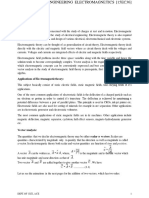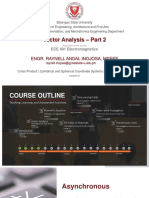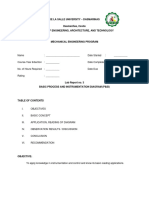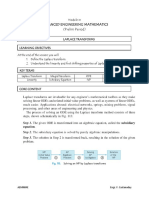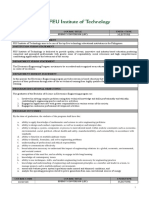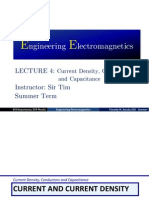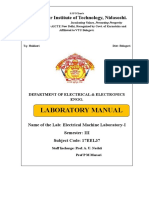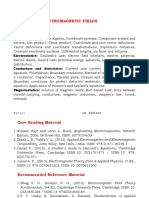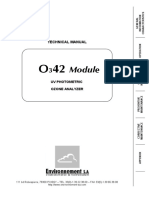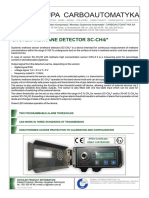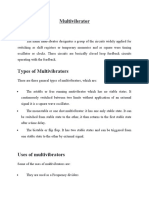EE331
Electromagnetics
LECTURES 1-6
Introduction to Electromagnetics
Dr. Aly Aboulnaga
aaboulnaga@kfu.edu.sa
Engineering Electromagnetics
Electric field
Produced by the presence of
electrically charged particles,
and gives rise to the electric
force.
Magnetic field
Produced by the motion of
electric charges, or electric
current, and gives rise to the
magnetic force associated
with magnets.
1
� Engineering Electromagnetics
An electromagnetic field is
generated when charged
particles, such as electrons, are
accelerated.
All electrically charged particles
are surrounded by electric
fields.
Charged particles in motion
produce magnetic fields.
When the velocity of a charged
particle changes, an
electromagnetic field is
produced.
All electromagnetic waves travel
at the same speed.
In a vacuum (space), they travel
at 300,000,000 m/s
Engineering Electromagnetics
Why do we learn Engineering
Electromagnetics?
Electromagnetics is Everywhere
Electromagnetics is fundamental to the
advancement of electrical and
computer technology!
2
�Why Study Electromagnetics?
Electrical Engineering is Applied Electromagnetics
EM is the basis for many devices (machinery, antennas, etc.), and one of
the physical foundations of any active electronic device.
As use of the electromagnetic frequency spectrum increases, the demand
for engineers who have practical working knowledge in the area of
electromagnetics continues to grow.
Electromagnetic engineers design: high frequency or optoelectronic
circuits, antennas and waveguides; electrical circuits that function
properly in the presence of external interference while not interfering
with other equipment.
The electromagnetics technical specialty prepares future engineers for
employment in industry in the areas of radar, antennas, fiber optics, high
frequency circuits, electromagnetic compatibility and microwave
communication.
What is Electromagnetics?
• Electromagnetics is the study of Charges:
(i) at rest (ii) in motion
• The subject of electromagnetics may be divided into 3 branches:
• Electrostatics: charges are at rest (no time-variation)
• Magnetostatics: charges are in steady-motion (no time-variation)
• Electrodynamics: charges are in time-varying motion
(give rise to waves that propagate and carry energy and
information)
Steps in Studying Electromagnetics
• Define basic quantities (e.g., E-field, H-field)
• Define the rules of operation (mathematics) of these quantities (e.g.,
Vector Algebra, PDEs)
3
� Examples of Electromagnetic Applications
Engineering Electromagnetics
Electric and magnetic field exist nearly everywhere.
4
�• The electromagnetic waves are grouped into types that have similar
wavelengths and so have similar properties.
radio visible gamma
microwaves infrared ultraviolet X-rays
waves light rays
100 m 10 cm 1 mm 0.01 mm 100 nm 1 nm 0.01 nm
smaller wavelength → higher frequency → energy and hazard
Electromagnetic waves form a continuous series in order of changing
wavelength, frequency and energy. This series is called the
electromagnetic spectrum.
Engineering Electromagnetics
Applications
Electromagnetic principles find application in various
disciplines such as microwaves, x-rays, antennas, electric
machines, plasmas, etc.
Antenna
Technology
5
� Engineering Electromagnetics
Electromagnetic fields are used in induction heaters for
melting, forging, annealing, surface hardening, and soldering
operation.
Electromagnetic devices include transformers, radio, television,
mobile phones, radars, lasers, etc.
Engineering Electromagnetics
A hard drive reads and writes data by using electromagnetism.
The basic principle:
(Write) If electric current (in form of digital signal) flows through a
conductor, then a magnetic field is generated around the conductor.
(Read) If a conductor pass through a magnetic field, then electric
current (in form of digital signal) is generated.
The disk constitutes the actual storage medium, consists of some
form of substrate material (such as aluminium) on which a layer of
magnetizable material has been deposited.
As the field passes through the medium directly under the gap, it
polarizes the magnetic particles so they are aligned with the field.
Hard drive: Storage
6
� Engineering Electromagnetics
Levitated trains: Maglev
prototype
A magnetic traveling field moves the
vehicle without contact.
The speed can be continuously
regulated by varying the frequency of
the alternating current.
Engineering Electromagnetics
AGM-88E Anti-Radiation
Guided Missile
Able to guide itself to destroy a radar E-bomb (Electromagnetic-
using the signal transmitted by the pulse bomb)
radar.
Destroy radar and intimidate its Designed to attack people’s
operators, creates hole in enemy dependency on electricity.
defense. Instead of cutting off power in an
Unit cost US$ 284,000 – US$ area, an e-bomb would destroy most
870,000. machines that use electricity.
Generators, cars, telecommunications
Military and Defense would be non operable.
Applications
7
� Engineering Electromagnetics
Chapter 1:
Vector Analysis
Chapter 1 Vector Analysis
Scalars and Vectors
Scalar refers to a quantity whose value may be represented
by a single (positive or negative) real number.
Some examples include distance, temperature, mass,
density, pressure, volume, and time.
A vector quantity has both a magnitude and a direction in
space. We especially concerned with two- and three-
dimensional spaces only.
Displacement, velocity, acceleration, and force are examples
of vectors.
• Scalar notation: A or A (italic or plain)
→
• Vector notation: A or A (bold or plain with arrow)
8
�Chapter 1 Vector Analysis
Vetor Algebra
ABBA
A(
B +
CA
)(
B)+C
A
AB
(B)
A 1
A
n n
AB 0
AB
Chapter 1 Vector Analysis
Vector Components and Unit Vectors
R PQ ?
rxyz
rxaxyayzaz
aaa
, , :uni
t v
e c
t
ors
x y z RPQ rQrP
(
22
x
aaya
)
z
(
123
aaa
x y )
z
ax4
ay2
az
9
� Vector Expressions in Rectangular
Coordinates
General Vector, B:
Magnitude of B:
Unit Vector in the
Direction of B:
1-19
Chapter 1 Vector Analysis
Vector Components and Unit Vectors
For any vector B, BBa
x x
Byay+a
B :
zz
B
x yz B
2 2 2
B B B Magnitude of B
B B
B
a Unit vector in the direction of B
xy
2
B B2 2
B
z
B
Example
Given points M(–1,2,1) and N(3,–3,0), find RMN and aMN.
R
M
N
(
3a
x
3
a
y0a
)
z
(
1a
x2
a
y1a
)
z4
ax5
ayaz
RMN 4a5y
a 1
a
aMN x z
0
.
617
ax0
.
772
ay0
.
154
az
RMN 4
2
)
(52
(1)2
10
�Vector Addition
Q: Say we add two vectors 𝐴 and 𝐵 together; what is
the result?
A: The addition of two vectors results in another vector, which we will
denote as 𝐶. Therefore, we can say:
A B C
The magnitude and direction of 𝐶 is determined by the head-to-tail rule.
This is not a provable result, rather the head-to-tail rule is the
definition of vector addition. This definition is used because it has
many applications in physics.
Some important properties of vector addition:
1. Vector addition is commutative: 𝐴 + 𝐵 = 𝐵 + 𝐴
2. Vector addition is associative: 𝑋 + 𝑌 + 𝑍 = 𝑋 + (𝑌 + 𝑍) = 𝐾
From these two properties, we can conclude that the
addition of several vectors can be executed in any order
Multiplication
• Consider a scalar quantity a and a vector quantity 𝐵. We
aB C
express the multiplication of these two values as:
In other words, the product of a scalar and a vector is a vector!
Q: OK, but what is vector 𝐶? What is the meaning of 𝐶?
A: The resulting vector 𝐶 has a magnitude that is equal to a
C a B
times the magnitude of 𝐵. In other words:
The direction of vector 𝐶 is exactly that of 𝐵.
→ Jut to reiterate, multiplying a vector by a scalar changes the magnitude of
the vector, but not its direction.
11
�Multiplication (contd.)
Some important properties of vector multiplication:
1. The scalar-vector multiplication is distributive: aB bB a b B
2. also distributive as: aB aC a B C
3. Scalar-Vector multiplication is also commutative: aB Ba
4. Multiplication of a vector by a negative scalar is
interpreted as:
aB a B
5. Division of a vector by a scalar is the same as B 1 B
multiplying the vector by the inverse of the scalar: a a
Unit Vector
• Lets begin with vector 𝐴. Say we divide this vector by its
aˆA A
magnitude (a scalar value). We create a new vector, which A
we will denote as 𝑎𝐴:
Q: How is vector 𝑎𝐴 related to vector 𝐴?
• But, the A
A: Since we divided 𝐴 by a scalar value, the magnitude of âA 1
vector 𝑎𝐴 has the same direction as vector 𝐴. A
𝑎𝐴 is:
The vector 𝑎𝐴 has a magnitude equal to one! We call such a
vector a unit vector.
• A unit vector is essentially a description of direction only, as its
magnitude is always unit valued (i.e., equal to one). Therefore:
• |𝐴|is a scalar value that describes the magnitude of vector 𝐴.
• 𝑎𝐴 is a vector that describes the direction of 𝐴.
12
�Chapter 1 Vector Analysis
The Cross Product
Given two vectors A and B, the magnitude of the cross product,
or vector product, written as AB, is defines as the product of
the magnitude of A, the magnitude of B, and the sine of the
smaller angle between them.
The direction of AB is perpendicular to the plane containing A
and B and is in the direction of advance of a right-handed
screw as A is turned into B.
ABaA
N B
si
n
AB ax ay az
ay az ax
The cross product is a vector, and it is az ax ay
not commutative:
)
(BA
(AB)
The Dot Product
• The dot product of two vectors, 𝐴 and 𝐵, is denoted as 𝐴 . 𝐵
A.B A B cosAB
θAB 𝐵
𝐴
angle θAB is the angle formed between the
vectors 𝐴 and 𝐵. 0 A
B
IMPORTANT NOTE: The dot product is an operation involving two
vectors, but the result is a scalar !! e.g.,:
A.B The dot product is also called the scalar
c product of two vectors.
• Note also that the dot product is commutative, i.e.,:
A.B B.A
13
� Operational Use of the Dot Product
Given
Find
where we have used:
Note also:
1-27
The Dot Product (contd.)
1. The dot product of a vector with itself is equal to the magnitude of the
vector squared.
2
A. A A . A cos0 A A
A.
A
2. If 𝐴 . 𝐵 = 0 (and 𝐴 ≠ 0, 𝐵 ≠ 0), then it must be true that: A 90
B
3. If 𝐴 . 𝐵 = |𝐴 ||𝐵|, then it must be true that: AB 0
4. If 𝐴 . 𝐵 = −|𝐴 ||𝐵|, then it must be true that: A 180
B
5. The dot product is distributive with addition, such that:
A. B C A.B A.C
14
�The Cross Product
• The cross product of two vectors, 𝐴 and 𝐵, is denoted as 𝐴 × 𝐵.
A B ân A B sinAB 0 A
B
Just as with the dot product, the angle θAB θAB
is the angle between the vectors 𝐴 and 𝐴 𝐵
𝐵.The unit vector 𝑎𝑛 is orthogonal to both
𝐴 and 𝐵(i.e., 𝑎𝑛.𝐴 =0 and 𝑎𝑛.𝐵 =0.) 𝐴 ×𝐵
IMPORTANT NOTE: The cross product is an operation involving two
vectors, and the result is also a vector. e.g.,:
𝐴 ×𝐵 =𝐶
• The magnitude of vector 𝐴 × 𝐵 is therefore: A B A B sinAB
While the direction of vector 𝐴 × 𝐵 is described by unit vector 𝑎𝑛.
The Cross Product (contd.)
Problem! There are two unit vectors that satisfy the equations
𝑎𝑛 . 𝐴 =0 and 𝑎𝑛 . 𝐵 =0!! These two vectors are
antiparallel.
𝑎𝑛2 A.ân1 A.ân 2 0 B.ân1 B.ân 2 0 ân1 ân 2
𝐴 𝐵
𝐴 ×𝐵
𝑎𝑛1
𝐴
Q: Which unit vector is correct?
A: Use the right-hand rule
𝐵
15
� Cross Product
1-31
Operational Definition of the Cross Product in
Rectangular Coordinates
Begin with:
where
Therefore:
Or…
1-32
16
�The Cross Product (contd.)
1. If θAB = 90ο (i.e., orthogonal), then: A B ân A B sin90 ân A B
2. If θAB = 0ο (i.e., parallel), then: A B ân A B sin0 0
Note that 𝑨 × 𝑩 = 𝟎 also if θAB = 180ο.
3. The cross product is not commutative! In other words, 𝐴 × 𝐵 ≠ 𝐵 × 𝐴.
While evaluating the cross product of two vectors,
𝐴 × 𝐵 ≠ −(𝐵 × 𝐴)
the order is important !
4. The negative of the cross product is: ( A B) A
( B)
5. The cross product is also not associative: A B C A B C
6. But, the cross product is distributive, in that: A B C A B A C
The Triple Product
• The triple product is not a “new” operation, as it is simply a combination
of the dot and cross products.
• For example, the triple product of vectors 𝐴 , 𝐵 , and 𝐶 is denoted as:
A.B C
Q: Yikes! Does this mean: A.B C OR A.B C
of these two interpretations makes sense:
A: The answer is easy! Only one
A.B C Scalar X Vector makes no sense
A. B C Vector . Vector dot product
17
� Coordinate System
Cartesian Coordinates
• In two dimensions, we can specify a point on a plane using two scalar
values, generally called X and Y.
Y-axis We can extend this to three-
dimensions, by adding a third
scalar value Z.
Z-axis
X P (X, Y)
P (X, Y, Z)
Y
Origin
X-axis
Y-axis
Origin
P’ (X, Y, Z)
X-axis
18
� Point Locations in Rectangular Coordinates
1-37
Cartesian Coordinates
• Note the coordinate values in the
Z-axis
Cartesian system effectively
represent the distance from a plane
intersecting the origin. 2
• For example, x =3 means that the 3
point is 3 units from the y-z plane P (2, 3, 2.5)
(i.e., the x = 0 plane). P (0, 0, 0)
2.5 Y-axis
• Likewise, the y coordinate provides
the distance from the x-z (y=0)
plane, and the z coordinate provides
the distance from the x-y (z =0)
plane. X-axis
• Once all three distances are
specified, the position of a point is
uniquely identified.
19
�Chapter 1 Vector Analysis
Rectangular Coordinate System
• Differential surface units:
dx dy
dy dz
dx dz
• Differential volume unit :
dx dy dz
Cylindrical Coordinates
• You’re also familiar with polar coordinates. In two dimensions, we specify
a point with two scalar values, generally called ρ and φ.
We can extend this to 3-dimensions, by adding a third
scalar value z. This method for identifying the position of a
point is referred to as cylindrical coordinates.
Y-axis Z-axis
P (ρ, φ, z)
P (ρ, φ)
ρ Y-axis
φ
X-axis
X-axis
20
�Cylindrical Coordinates
Note the physical significance of each
parameter of cylindrical coordinates:
1. The value ρ indicates the distance of Z
the point from the z-axis (0 ≤ r<∞).
2. The value φ indicates the rotation
3 P (3, 60ο, 2.5)
angle around the z-axis (0≤φ<2π),
precisely the same as the angle φ used 60ο
in spherical coordinates. 2.5
3. The value z indicates the distance of
the point from the x-y (z = 0) plane
(−∞<z<∞), precisely the same as the
coordinate z used in Cartesian P (0, φ, 0)
coordinates.
4. Once all three values are specified, the
position of a point is uniquely
identified.
Circular Cylindrical Coordinates
Point P has coordinates
Specified by P (rz)
1-42
21
�Orthogonal Unit Vectors in Cylindrical
Coordinates
1-43
Differential Volume in Cylindrical
Coordinates
dV = dddz
1-44
22
�Point Transformations in Cylindrical Coordinates
1-45
Dot Products of Unit Vectors in Cylindrical and
Rectangular Coordinate Systems
1-46
23
�Example: Transform the vector,
into cylindrical coordinates:
Finally:
1-47
Spherical Coordinates
Point P has coordinates
Specified by P(r)
1-48
24
�Constant Coordinate Surfaces in Spherical
Coordinates
Unit Vector Components in Spherical
Coordinates
dV = R2 sindr dd
25
�Dot Products of Unit Vectors in the Spherical and
Rectangular Coordinate Systems
1-51
Example: Vector Component Transformation
Transform the field, , into spherical coordinates and components
26
�Spherical Coordinates
• Geographers specify a location
on the Earth’s surface using three
scalar values: longitude, latitude,
and altitude.
• Both longitude and latitude are
angular measures, while altitude
Z-axis
is a measure of distance.
• Latitude, longitude, and altitude
P (r, θ, φ)
are similar to spherical
coordinates.
• Spherical coordinates consist of
Y-axis
one scalar value (R), with units of
distance, while the other two
scalar values (θ, φ) have angular
units (degrees or radians).
X-axis
Spherical Coordinates
• For spherical coordinates, r (0≤R<∞)
expresses the distance of the point
from the origin (i.e., similar to
altitude). P (3, 45ο, 60ο)
• Angle θ (0 ≤θ ≤π) represents the angle θ = 45ο
formed with the z-axis (i.e., similar to
P (0, θ, φ) r=3
latitude).
• Angle φ (0≤φ<2π) represents the
rotation angle around the z-axis,
φ = 60ο
precisely the same as the cylindrical
coordinate φ (i.e., similar to
longitude).
Thus, using spherical coordinates, a point in space can be
unambiguously defined by one distance and two angles.
27
�Coordinate Transformations
• Say we know the location of a point, or the description of some scalar
field in terms of Cartesian coordinates (e.g., T (x, y, z)).
• What if we decide to express this point or this scalar field in terms of
cylindrical or spherical coordinates instead?
• We see that the coordinate values z, r, R, and θ are all variables of a right
triangle! We can use our knowledge of trigonometry to relate them to
each other.
• In fact, we can completely derive the relationship between all six
independent coordinate values by considering just two very important
right triangles!
• Hint: Memorize these 2 triangles!!!
Coordinate Transformations (contd.)
Combining the results of the two triangles allows us to write
each coordinate set in terms of each other
• Cartesian and Cylindrical • Cartesian and Spherical
r x2 y2 R x2 y2 z2
1 y cos 1
z
tan x x y2 z
2 2
z
z tan 1 y
x
x rcos
x R sin cos
y rsin
y R sin sin
zz
z R cos
28
�Example – 1
• Say we have denoted a point in space (using Cartesian Coordinates) as
𝑃 𝑥 = −3, 𝑦 = −3, 𝑧 = 2 .
• Let’s instead define this same point using cylindrical coordinates 𝜌, 𝜙, 𝑧.
r (3)2 (3)2 3 2 tan 1 3
45
z2
3
Therefore, the location of this point can perhaps be defined also as
𝑃 r = 3 2, ϕ = 45ο, 𝑧 = 2 .
Q: Wait! Something is wrong.
Coordinate ϕ = 45ο indicates that point P
is located in quadrant-I, whereas the
coordinates x =-3, y =-3 tell us it is in fact
in quadrant-III!
Example – 1 (contd.)
A: The problem is in the interpretation of the inverse tangent!
Remember that 0≤ϕ<360ο, so that we must do a four quadrant inverse
tangent. Your calculator likely only does a two quadrant inverse tangent
(i.e., 90ο≤ϕ≤−90ο), so be careful!
Therefore, if we correctly find the coordinate ϕ: tan 1 3
225
3
The location of point P can be expressed as
either 𝑃 𝑥 = −3, 𝑦 = −3, 𝑧 = 2 or
𝑃 r = 3 2, ϕ = 225ο, 𝑧 = 2 .
29
� Example – 2
Coordinate transformation on a Scalar field
• Consider the scalar field (i.e., scalar function): g (,, z) 3 z sin
rewrite this function in terms of Cartesian coordinates.
• Note that since r x2 y2
• Now, what about sinϕ?
We know that tan 1 y , We might be tempted to write:
x
y
Technically correct, this is one
sin sin tan
1
x ugly expression. We can
instead turn to one of the very
important right triangles that
we discussed earlier
Example – 2 (contd.)
Y
From this triangle, it is apparent that:
ρ
y sin
y
x y2
2
ϕ
x X
As a result, the scalar field can be written in Cartesian
coordinates as:
g ( x, y, z ) x2 y2 y z x2 y2 yz
3/2
x2 y2
30
�Example – 2 (contd.)
Although the scalar fields: g ( r,, z) r 3 z sin and g ( x, y, z ) x y yz
2 2
look very different, they are in fact exactly the same functions—only
expressed using different coordinate variables.
• For example, if you evaluate each of the scalar fields at the point
described earlier, you will get exactly the same result!
g ( x 3, y 3, z 2) 108
g (r 3 2, 225, z 2) 108
31

